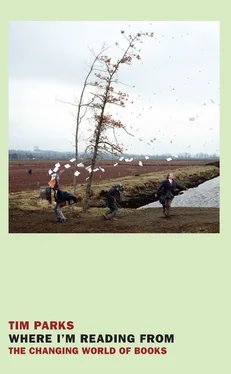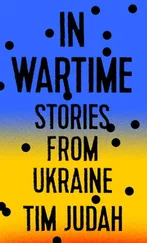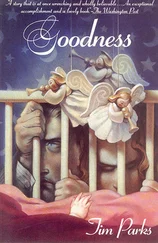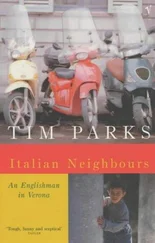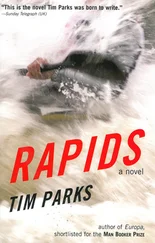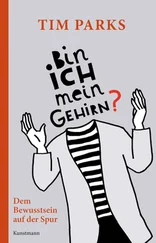And of course all these literary achievements are wonderful and “enriching” (as they say) and infinitely more attractive than the dull documents I and my colleagues are compiling to describe our degree course to the European Commission; nevertheless they share with that document and with the people who devised it the desire for a control that stands off from participation, and perhaps substitutes for it. Similarly, the windy length of Dickens’s denunciation of the Circumlocution Office, and the lingering pleasure he evidently takes in blowing it away, share that office’s sinister vocation, which is why, as Orwell says, the bureaucrats themselves recognize and love the spirit of the passage. One almost feels it’s worth having a Circumlocution Office so Dickens can describe it. A dangerous state of mind.
The question arises: Is all locution inevitably circumlocution (as Beckett tended to think), and will the West perhaps slowly and voluptuously choke itself in a mounting tangle of red tape, meantime entertaining itself to death with a mountain of literature that describes and charmingly castigates the whole scandalous process? Wouldn’t it be strange, in the end, if there were not a continuity of vocation between these two major facets of the same culture? Here am I, after all, writing about other people writing about things, and with a little luck someone writing somewhere else will castigate me for my cynicism and irresponsibility, since we all know that literature, like democracy (and most of all the British democracy that gave us the Circumlocution Office), must always be praised to high heaven.
1 Translation by Gitta Honegger in her biography, Thomas Bernhard: The Making of an Austrian , Yale University Press, 2001, p. 36.
IN THE CHLOROFORMED SANCTUARY
“WALK AROUND A university campus,” fumes Geoff Dyer in Out of Sheer Rage , “and there is an almost palpable smell of death about the place because hundreds of academics are busy killing everything they touch.” Is Dyer correct that while original literature throbs with life, literary criticism is the work of cloistered drudges who suffocate the very creature that provides them with a living?
At least on this score reviewers can be quickly exonerated; it may be miles away from facing and firing bullets, or performing open heart surgery, but reviewing does have an immediate impact on other people’s lives. Panning or praising a novel, the reviewer is aware he is administering pain or pleasure and that quite possibly there will be a reaction, as when Jeanette Winterson turned up on a reviewer’s doorstep to berate him in person for a poor review. One celebrated novelist who felt I had reviewed him unkindly spent an hour making a transatlantic phone call to my own publisher to complain about my wickedness. A reviewer fearful of the fray would be well advised to find another job.
Not so the academic critic. While the reviewer is generally freelance and may hope to increase his or her income through a policy of lively provocation and polemics, the academic, though hardly well off, is more reliably salaried within a solid university institution. Rather than being part of the market with the obvious function of swaying reader’s purchasing choices, these critics treat literature as an object of quasi-scientific research. They’re not obliged to entertain, but then nor is there any question of their findings being used to propose any program of improvement; they needn’t fear the moment when their work is measured against reality. In short, the academic critic’s task is purely one of exegesis and clarification. So it may come as a surprise to those unfamiliar with this kind of writing how frequently it resorts to a jargon and manner that guarantees ordinary consumers of literature will be repelled.
Here are three typical passages, none of them extreme, the first pulled (at random) from an essay by Paul Davies in The Cambridge Companion to Beckett :
From its first words, then, Comment c’est acknowledges the aesthetic of recommencement that Beckett had already developed with such compaction in Texts . Working together, these two projects carry out the wisdom of the pun: “commencer” is “comment c’est.” Beginning again, he returns again. Commencing, he quotes. As I argued above, it was the insistence of this insight that had led Beckett in the Texts to the strategic deployment of the gap between texts. These twelve gaps were in their turn yet another seed for How it is . They grew into roughly eight-hundred-and-twenty-five gaps, each of which, as John Pilling has pointed out, enabled a formal re-enactment of the book’s inception.
Here, equally at random from the shelves beside my desk, is Amit Chaudhuri writing about Lawrence’s poems in Birds, Beasts and Flowers :
What is agreed upon generally then is that, to appropriate a term from linguistics, the “signified” of the poem is undefinable, powerful, ineffable, but mysteriously transmissible and even paraphrasable. This “signified” which may be called “otherness” or “life,” lies outside the text, out there in the landscape or object described, while each signifier—bat, snake, eagle, tortoise, fish—makes a connection with the “signified,” thus capturing, conveying or evoking it.
Finally, from the realm of translation criticism, this is Lawrence Venuti, in Rethinking Translation , talking about Iginio Tarchetti’s nineteenth-century Italian “adaptations” of stories by Mary Shelley:
Yet Shelley’s authorship comes back to worry the ideological standpoint of Tarchetti’s intervention by raising the issue of gender. To be effective as a subversion of bourgeois values which deterritorializes the Italian literary standard, his text must maintain the fiction of his authorship, referring to Shelley’s tale only in the vaguest way (‘imitation’). At the same time, however this fiction suppresses an instance of female authorship so that the theft of Shelley’s literary creation has the patriarchal effect of female disempowerment, of limiting a woman’s social agency.
All three of these pieces contain useful, almost “common sense” observations on the texts they are talking about. Yet this common sense is made to seem arduous through the use of unnecessary jargon. There is also a solemnity that combines with the ugliness of style to push the writing toward bathos. I suspect Davies’s metaphor of “twelve gaps” being “a seed” that “grew into roughly eight-hundred-and-twenty-five gaps” would have had Beckett laughing out loud.
The mix of intellectual control and creeping tedium goes hand in hand with a focus on the arcane rather than the evident; technique rather than content. Areas where the critic can claim special expertise are stressed, while a book’s part in the writer’s life is played down, as if for fear that any layman might feel he had the right to discuss such matters. Academics are naturally attracted to the kind of writer whose flaunted complexity offers scope for that expertise, rather than one taking on his material in a more direct fashion. So Joyce is infinitely preferred to Chesterton (in passing it’s interesting that Borges, himself the object of endless academic criticism, preferred Chesterton to Joyce).
What is in it for these critics? They stake out a field in which only a relatively small group of initiates can compete; their writing is safe from public scrutiny, it threatens no one and can do little damage; at the same time they may enjoy the illusion of possessing, encompassing, and even somehow neutralizing the most sparkling and highly regarded creations of the imagination.
This is what Dyer so comically hates in Out of Sheer Rage . Here he is opening the Longman Critical Reader to his favorite author, D.H. Lawrence:
Читать дальше
